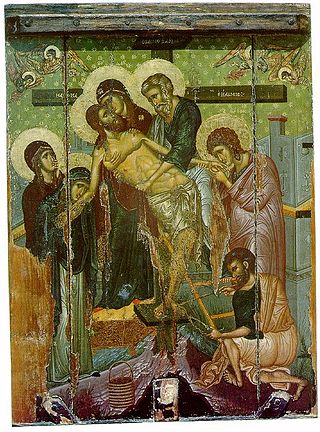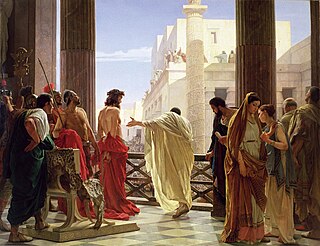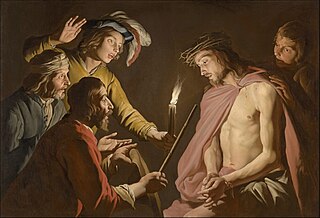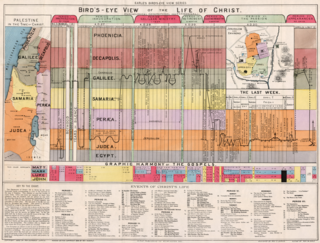
Joseph of Arimathea is a Biblical figure who assumed responsibility for the burial of Jesus after his crucifixion. Three of the four canonical Gospels identify him as a member of the Sanhedrin, while the Gospel of Matthew identifies him as a rich disciple of Jesus. The historical location of Arimathea is uncertain, although it has been identified with several towns. A number of stories about him developed during the Middle Ages.

Pontius Pilate was the fifth governor of the Roman province of Judaea, serving under Emperor Tiberius from 26/27 to 36/37 AD. He is best known for being the official who presided over the trial of Jesus and ultimately ordered his crucifixion. Pilate's importance in Christianity is underscored by his prominent place in both the Apostles' and Nicene Creeds. Because the gospels portray Pilate as reluctant to execute Jesus, the Ethiopian Orthodox Tewahedo Church believes that Pilate became a Christian and venerates him as both a martyr and a saint, a belief which is historically shared by the Coptic Church, with a feast day on 19 or 25 June, respectively.

The Passion is the short final period before the death of Jesus, described in the four canonical gospels. It is commemorated in Christianity every year during Holy Week.

The Gospel of Peter, or the Gospel according to Peter, is an ancient text concerning Jesus Christ, only partially known today. Originally written in Koine Greek, it is a non-canonical gospel and was rejected as apocryphal by the Church's synods of Carthage and Rome, which contributed to the establishment of the New Testament canon. It was the first of the non-canonical gospels to be rediscovered, preserved in the dry sands of Egypt.

The Gospel of Nicodemus, also known as the Acts of Pilate, is an apocryphal gospel claimed to have been derived from an original Hebrew work written by Nicodemus, who appears in the Gospel of John as an associate of Jesus. The title "Gospel of Nicodemus" is medieval in origin. The dates of its accreted sections are uncertain, but the work in its existing form is thought to date to around the 4th or 5th century AD.

A chronology of Jesus aims to establish a timeline for the events of the life of Jesus. Scholars have correlated Jewish and Greco-Roman documents and astronomical calendars with the New Testament accounts to estimate dates for the major events in Jesus's life.

The New Testament apocrypha are a number of writings by early Christians that give accounts of Jesus and his teachings, the nature of God, or the teachings of his apostles and of their lives. Some of these writings were cited as scripture by early Christians, but since the fifth century a widespread consensus has emerged limiting the New Testament to the 27 books of the modern canon. Roman Catholic, Eastern Orthodox, and Protestant churches generally do not view the New Testament apocrypha as part of the Bible.
The Gelasian Decree is a Latin text traditionally thought to be a decretal of the prolific Pope Gelasius I (492-496). The work consists of five chapters: the second chapter of which is a list of books of Scripture defined as part of the biblical canon by a Council of Rome, traditionally dated to Pope Damasus I (366–383) and thus known as the Damasine List. The fifth chapter of the work includes a list of works not encouraged for church use.
The unnamed wife of Pontius Pilate appears only once in the Gospel of Matthew (27:19), where she intercedes with Pilate on Jesus' behalf. It is uncertain whether Pilate was actually married, although it is likely. In later tradition, she becomes known as Procula, Procla or Procle and plays a role in various New Testament Apocrypha. At a later date, she acquires the name Claudia Procula in Western tradition, as well as other names and variants of these names. She is venerated as a saint by the Eastern Orthodox Church, the Eastern Catholic Church, the Coptic Church, and the Ethiopian Church. She has also frequently been featured in literature and film.

The Gospel of Bartholomew is a missing text amongst the New Testament apocrypha, mentioned in several early sources. It may be identical to either the Questions of Bartholomew, the Resurrection of Jesus Christ, or neither.

The Revelation of Stephen, or Apocalypse of Stephen, is a text of New Testament apocrypha. It features Saint Stephen, one of the Seven Deacons to the Twelve Apostles.
The Lost Books of the Bible and the Forgotten Books of Eden (1926) is a collection of 17th-century and 18th-century English translations of some Old Testament Pseudepigrapha and New Testament Apocrypha, some of which were assembled in the 1820s, and then republished with the current title in 1926.

In the New Testament, the Sanhedrin trial of Jesus refers to the trial of Jesus before the Sanhedrin following his arrest in Jerusalem and prior to the trial before Pontius Pilate. It is an incident reported by all three Synoptic Gospels of the New Testament, while the Gospel of John refers to a preliminary inquiry before Annas. The gospel accounts vary on a number of details.
Matthew 28:14 is the fourteenth verse of the twenty-eighth chapter of the Gospel of Matthew in the New Testament. This verse is part of the resurrection narrative. In this verse the priests of Jerusalem assured the safety of the tomb guards should the governor, Pontius Pilate, receive report of their failure.

The following outline is provided as an overview of and topical guide to Christianity:
On the Life and the Passion of Christ is an apocryphal account of Jesus written in Sahidic. According to its written introduction, it is "a homily which the holy Apa Cyril [...] delivered", meaning Cyril of Jerusalem. Scholars, however, assume the homily to be a Pseudo-Cyrillian work. It is dated no earlier than the 8th century AD and, according to the introduction, was delivered "in the early morning of the fourth day of the Great Pascha", making it an Easter homily focusing mostly on the passion of Christ.

Vindicta Salvatoris is a text of New Testament Apocrypha that expands the story of the aftermath of Jesus's execution. It was often presented as a supplement to the Gospel of Nicodemus. The oldest known copies are two Latin versions of the Vindicta Salvatoris, both dated to the 8th or 9th centuries and likely when the work was authored. The work is thought to have been composed in southern France, perhaps the Aquitaine region.

The Pilate cycle is a group of various pieces of early Christian literature that purport to either be written by Pontius Pilate, or else otherwise closely describe his activities and the Passion of Jesus. Unlike the four gospels, these later writings were not canonized in the New Testament, and hence relegated to a status of apocrypha. Some writings were quite obscure, with only a few ancient textual references known today; they merely survived through happenstance, and may not have been particularly widely read by early Christians in the Roman Empire and Christians in the Middle Ages. Others were more popular. The most notable example was the Gospel of Nicodemus, which proved quite popular and influential in medieval and Renaissance Christianity.








